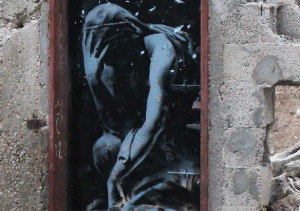 As further evidence of the escalating value of graffiti art, police in Gaza seized a work by Banksy after it was removed from the rubble of a landowner’s home. According to the landowner, a group of men convinced him that they were acting on behalf of Banksy, wanting to buy the door from the home’s rubble as it was part of a series by the well-known graffiti artist. In truth, Banksy had no affiliation with the group and the rightful owner is now seeking to have the work returned.
As further evidence of the escalating value of graffiti art, police in Gaza seized a work by Banksy after it was removed from the rubble of a landowner’s home. According to the landowner, a group of men convinced him that they were acting on behalf of Banksy, wanting to buy the door from the home’s rubble as it was part of a series by the well-known graffiti artist. In truth, Banksy had no affiliation with the group and the rightful owner is now seeking to have the work returned.
The landowner received $175 for the door, although Banksy’s works sell for hundreds of thousands of dollars. Although various jurisdictions in the US and abroad have penal codes criminalizing the placement of graffiti on public spaces and on private space when no consent is granted, Banksy has never been charged with vandalism. In fact, most landowners presumably would relish having a Banksy on his property as the art world views Banksy’s creations as high-value art.
In February of this year, Banksy released a series of new works in Gaza, all commenting on the dire situation of the 1.8 million Palestinian residents confined to the area. His website states, “Gaza is often described as ‘the world’s largest open air prison’ because no-one is allowed to enter or leave. But that seems a bit unfair to prisons — they don’t have their electricity and drinking water cut off randomly almost every day.”
To hear more about Banksy and graffiti art, listen to Leila Amineddoleh’s radio interview from November 2013: http://www.wfuv.org/news/fordham-conversations/141209/fordham-conversations-graffiti-art